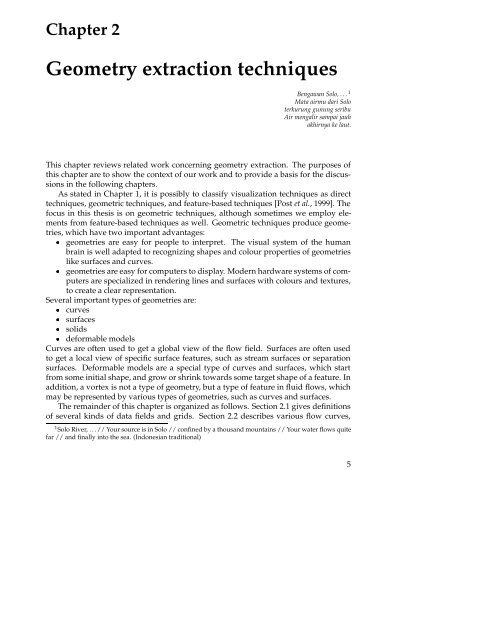Chapter 4 Vortex detection - Computer Graphics and Visualization
Chapter 4 Vortex detection - Computer Graphics and Visualization
Chapter 4 Vortex detection - Computer Graphics and Visualization
You also want an ePaper? Increase the reach of your titles
YUMPU automatically turns print PDFs into web optimized ePapers that Google loves.
<strong>Chapter</strong> 2<br />
Geometry extraction techniques<br />
Bengawan Solo, . . . 1<br />
Mata airmu dari Solo<br />
terkurung gunung seribu<br />
Air mengalir sampai jauh<br />
akhirnya ke laut.<br />
This chapter reviews related work concerning geometry extraction. The purposes of<br />
this chapter are to show the context of our work <strong>and</strong> to provide a basis for the discussions<br />
in the following chapters.<br />
As stated in <strong>Chapter</strong> 1, it is possibly to classify visualization techniques as direct<br />
techniques, geometric techniques, <strong>and</strong> feature-based techniques [Post et al., 1999]. The<br />
focus in this thesis is on geometric techniques, although sometimes we employ elements<br />
from feature-based techniques as well. Geometric techniques produce geometries,<br />
which have two important advantages:<br />
¯ geometries are easy for people to interpret. The visual system of the human<br />
brain is well adapted to recognizing shapes <strong>and</strong> colour properties of geometries<br />
like surfaces <strong>and</strong> curves.<br />
¯ geometries are easy for computers to display. Modern hardware systems of computers<br />
are specialized in rendering lines <strong>and</strong> surfaces with colours <strong>and</strong> textures,<br />
to create a clear representation.<br />
Several important types of geometries are:<br />
¯ curves<br />
¯ surfaces<br />
¯ solids<br />
¯ deformable models<br />
Curves are often used to get a global view of the flow field. Surfaces are often used<br />
to get a local view of specific surface features, such as stream surfaces or separation<br />
surfaces. Deformable models are a special type of curves <strong>and</strong> surfaces, which start<br />
from some initial shape, <strong>and</strong> grow or shrink towards some target shape of a feature. In<br />
addition, a vortex is not a type of geometry, but a type of feature in fluid flows, which<br />
may be represented by various types of geometries, such as curves <strong>and</strong> surfaces.<br />
The remainder of this chapter is organized as follows. Section 2.1 gives definitions<br />
of several kinds of data fields <strong>and</strong> grids. Section 2.2 describes various flow curves,<br />
1 Solo River, ...//Yoursource is in Solo // confined by a thous<strong>and</strong> mountains // Your water flows quite<br />
far // <strong>and</strong> finally into the sea. (Indonesian traditional)<br />
5

















